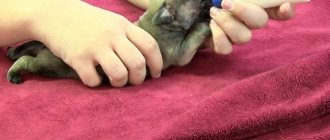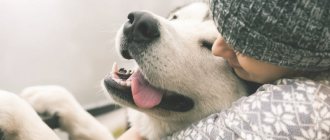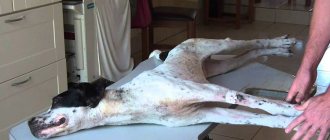Unfortunately, sometimes it happens that the bitch, for various reasons, cannot feed the puppies. For example, due to the fact that too little milk is produced, health problems or the mother’s abandonment of one of the children. If you want to check if your bitch has milk, you need to gently press on the breast nipple and see if a drop comes out. If this happens, then everything should be fine. You just need to make sure that all puppies have access to the nipple and that none of the little ones are pushed away by the others. The situation becomes more complicated when it turns out that there is no milk or there is too little milk to feed the entire litter. In this case, the puppy’s life will depend on you and artificial feeding of the puppies will be necessary.
You must take responsibility for feeding your small dog. The first step is to give him a milk replacer, this will provide the dose of essential nutrients and antibodies that the puppy should receive immediately after birth.
You cannot save on this product, because not only the growth and proper development of the puppy, but also its life depends on it.
Until what age does a puppy need to be fed?
In the first month of life, puppies are completely dependent on their mother. They are poorly oriented in space and practically do not leave the “nest”. The opening of the eyes and ear canals occurs only 14 days after birth. Until this point, the new mother is responsible not only for feeding her babies, but also for their thermoregulation.
On average, feeding lasts up to 2-2.5 months, but after 20-25 days, mononutrition stops due to the addition of complementary foods. By this age, puppies have erupted their milk teeth, and the lactating bitch begins to experience problems with lactation. All this leads to the need for a gradual transition to an adult diet.
Why it is not recommended to give baby food to dogs
It is not recommended to feed baby products, in particular purees, because regular feeding of such products alone does not put stress on the teeth, and the dog should train the jaw muscles. In addition, there may be problems with the gastrointestinal tract, diarrhea, vomiting, and allergic reactions.
The benefits of natural raw meat that has not been subjected to heat treatment and excessive grinding are greater than from boiled meat puree. It is better to feed even sick old and toothless dogs with natural products, grind them yourself, grind raw beef liver with carrots in a meat grinder, and give low-fat cottage cheese and eggs.
Baby food is not as nutritious as special foods, and the food needs of an animal are completely different from those of a human. Including such products in the diet increases the risk of causing addiction in your pet, as a result of which the animal will become picky about food.
Many people believe that baby food is of higher quality and better than dog food, because after all, it is made for children. But if you want to feed your dog well, then it is better to buy high-quality dog food or prepare food for your pets yourself.
Source
What to feed a newborn puppy left without a mother
Toothless pets cannot be fed with adult food, so there is only one option here - looking for a substitute for bitch milk. For constant feeding, special mixtures from a pet store are suitable, and before purchasing them, less healthy alternatives from your own refrigerator.
Bitch milk replacer from a pet store
The composition of ready-made milk mixtures is as close as possible to the original bitch milk. In addition to the standard set of proteins and fats, it includes the polyunsaturated acid DHA, which is necessary for brain development.
Formulas for newborns are produced by well-known companies. Most often, the package contains the following set:
- packages of instant milk;
- graduated bottle;
- several nipples of different sizes;
- measuring spoon.
On such a diet, newborns quickly gain weight, keeping up with the growth of those who are breastfed.
REFERENCE!
The most affordable and reliable option for feeding is a foster mother who has recently given birth to a small litter or has lost her cubs. The problem is that it is not so easy to find.
Alternative and fallback options
If feeding ready-made formulas is not possible for some reason, then diluted cow's cream and milk can be chosen as an alternative. This diet is less healthy, but still acceptable. The formula for preparing milk formula depends on the age of the baby:
- Less than 3 weeks.
Lactose, or milk sugar, is not absorbed by the stomach of newborns. To reduce its amount, the cream is diluted with boiled water. It also helps reduce their fat content to 9%, which is fully consistent with female colostrum. The ratio between cream and water should be 10:1.
- More than 3 weeks.
At this age, special enzymes appear in the body that break down lactose. Instead of cream, whole cow's milk with a fat content of 2.5-3.2%, mixed with beaten chicken eggs, is allowed. Thanks to the latter, the amount of protein and vitamin D in the homemade mixture increases.
When 3 weeks have passed, cereals crushed in a blender are also added to the milk mixture. Such watery porridges have a high calorie content and require longer digestion due to complex carbohydrates, which makes it easier for representatives of large breeds to become satiated.
IMPORTANT!
At the age of 4 months, animals develop lactose intolerance, so if bloating and diarrhea occur, all dairy products must be removed from the diet, leaving only sour milk.
As a backup option, a mixture of boiled water and glucose can be used. To prepare it you will need a glass of heated water and 1 teaspoon of honey. The recommended dose is 3.5 ml per 100 g of weight. You can stick to this diet for 1-2 days before purchasing a ready-made substitute.
What products should not be used
Prohibited foods include whole cow's and goat's milk. Both options are acceptable as emergency options for a couple of days, but no more. Their maximum fat content is only 3.3% and 3.8%, respectively, while newborns need 9.8%.
Before teething, it is also not recommended to introduce regular food: cereals, vegetables and meat. The gastrointestinal tract of newborns is not suitable for digesting them, so such a diet can lead to diarrhea, constipation and other intestinal disorders.
NOTE!
Don't leave uneaten mixture for later. Children should eat strictly freshly prepared and warm food.
Milk in the diet of adult dogs
Can an adult dog have milk? Veterinarians do not recommend giving it at all, much less including it as part of the daily diet. In addition, drinking often causes diarrhea, flatulence, and allergies in pets.
Can dogs drink milk if they tolerate the product normally, without bloating or diarrhea? Sometimes you can indulge, but you should know that it does not contain the necessary nutrients, so milk will not bring any benefit.
Other prohibited dairy products include:
- tan and ayran – fermented milk products with salt;
- condensed milk – contains many substances harmful to dogs, incl. sugar;
- ice cream – contains unhealthy fats, sugar, and other products that are harmful to the dog.
There are different opinions regarding fermented milk products. Many veterinarians do not recommend giving cheese, cottage cheese, and kefir. Their opponents argue that it is possible in small quantities, since lactic acid bacteria improve intestinal function, and calcium has a good effect on bones. Products must be natural, without flavoring or other additives.
Feeding frequency
The number of meals depends on two factors: the age and strength of the baby. Feeding recommendations up to 1 month are as follows:
- Every 2 hours without a night break in the first week of life. Premature and weakened pets are fed even more often - every 1.5 hours.
- Every 4 hours during the day with a night break of 6 hours from the second to third weeks.
- Approximately 6-8 times a day, starting from the third week. At this age, night snacks are completely excluded.
- Finally, 5-6 times a day, starting from the fourth week. Closer to the month, the first solid food is introduced into the diet: cottage cheese, cereals and dry food soaked in water.
After introducing complementary foods, small pets are gradually introduced to new products, increasing their share in the diet. By 5-6 weeks, artificial feeding is completely stopped in favor of “natural” or dry food.
“ More about feeding puppies
Read before offering formula to your puppy. Important information!
The birth of cute little puppies is always a joyful event in the life of every breeder. But sometimes the joy disappears when the bitch gives up her puppies.
If an adult dog is unable to feed its children, then you will have to resort to methods such as artificial feeding. This is not an easy task that requires patience, effort and time.
Step-by-step description of the procedure
Most often, dogs are bottle-fed with a nipple, but for small breeds a syringe and dropper are also suitable. The feeding procedure consists of the following steps:
- Disinfection. To avoid infecting babies, the owner must thoroughly wash their hands with soap and boil the milk container.
- Warming up. Powdered milk is diluted with water before each feeding and brought to a temperature of 38-40°C. If in the end there is something left in the bottle, then it is poured out.
- Correctly picking up a puppy. The small pet is placed on the lap with its tummy down and its head is gently lifted, imitating the natural position when suckling the breast.
- Putting down the bottle. It is held at an angle of 45°, avoiding too much pressure. Otherwise, the baby may choke. If the puppy himself tries to drink everything in one gulp, then take several forced breaks.
- Helps remove excess air. Once fed, the four-legged animal immediately turns away from the nipple. At this point, its position is changed to vertical and held for about 2 minutes until regurgitation.
A well-fed baby is placed in the opposite direction from his hungry brothers. This way you won’t confuse those who ate and those who didn’t – this especially helps if there are a lot of “babies” in the litter.
ADVICE!
If your pet pushes the pacifier away with its paws, swaddle it, limiting its mobility.
A hole in the nipple is punched with a hot needle. It shouldn't be too big or too small. Puppies should suckle easily without exerting too much force. If the liquid flows freely in a stream, make the hole smaller.
Additional baby care
To track the well-being of newborns, it is better to keep a special journal. It is convenient to monitor the frequency of meals, weight gain, stool consistency and alarming symptoms.
In addition to artificial feeding, caring for orphan puppies includes the following actions:
- Maintaining temperature in the “nest”. In the first 7 days it should be 30°C, in the second – 27°C, and in the third – 21-23°C. A heating pad or a special lamp for the incubator is suitable for heating. In both cases, the animals should be able to crawl to an unheated area when they feel hot. Otherwise they may overheat.
- Regular diaper changes and body cleanliness control. The immature urinary system of newborns does not allow urinary control. Because of this, kids constantly walk under themselves and can catch a cold from the dampness. In the absence of a lactating bitch, their dryness should be controlled by the owner.
- Using ointments for diaper rash. A humid environment is nutritious for bacteria and other pathogenic microorganisms, so along with hypothermia, small four-legged animals can develop skin inflammation. To prevent this form of dermatitis, the affected areas must be lubricated with any soothing baby cream.
- Taking your temperature before every meal. When the value is below 35.5°C, problems with digestion occur, leading to intestinal obstruction. If the thermometer shows too few degrees, warm your pet with your body heat by placing it under a sweater or other clothing.
- Accounting for weight changes. Newborns are weighed for the first time on the 2nd day of life. After this, changes are recorded daily. On average, the increase is up to 5% of the weight for the previous day. Stunted growth and even slight weight loss are acceptable only in the first 7 days. If on the 8th day the situation remains the same, contact your veterinarian.
- Massage before and after meals. It is necessary to stimulate the gastrointestinal tract. Massage is done with a damp cloth or cotton pad soaked in warm water, in the direction from the navel to the anus. Urine and feces appear quite quickly, within 1-2 minutes. They are carefully removed, avoiding drying out on their own.
After massaging the tummy, babies immediately fall asleep. This behavior in the first 7 days of life is absolutely normal and does not require help from a veterinarian.
Possible problems
Even with strict adherence to all of the above recommendations, a number of problems may arise during the care process. These include:
- Lack of satiety or overfeeding.
The first condition is easily recognized by the lack of weight gain, restless sleep and constant whining, and the second by greenish stool.
- Constipation or diarrhea.
In addition to consistency, you should monitor the color. If the natural shade has changed, consult your veterinarian
- Insufficient weight gain.
On days 8-10, the initial weight doubles. If there are no changes, your pets should be booked for examination at the nearest veterinary clinic - or invite a specialist to your home.
- Hypoglycemia, or low blood glucose levels.
The risk group includes dwarf breeds. The main symptoms are loss of appetite, chills, abnormal bowel movements, weakness, unsteadiness of gait.
- Inflammation of the navel.
Develops when asepsis is not observed during childbirth and the “nest” is not regularly cleaned. Without timely treatment, inflammation is complicated by sepsis.
- Conjunctivitis.
Occurs when the palpebral fissure becomes infected before it opens. The main symptoms are purulent discharge, swelling and redness of the eyelids.
- "Swimmer's Syndrome"
A genetic disorder that appears at 2-3 weeks of birth. A sick pet is unable to stand on its legs and makes “swimming” movements with them.
- Dehydration.
In addition to a lack of fluid in the diet, it is provoked by low humidity in the room.
Despite some difficulties, artificial feeding is almost as good as natural feeding. By preparing a high-quality diet, observing the frequency of feeding and proper care of newborns, you can raise healthy and strong dogs, no different from those who grew up with their mother.
Do you like the article? 0











